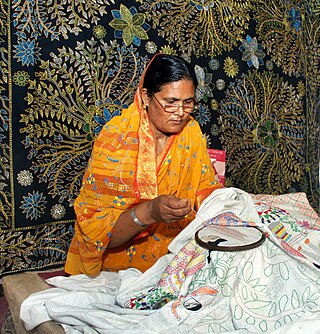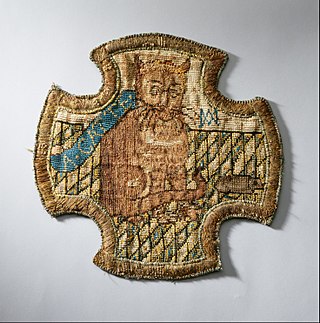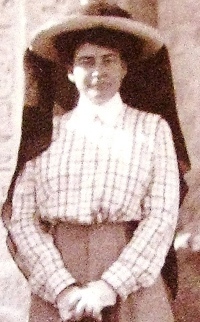
Embroidery is the art of decorating fabric or other materials using a needle to stitch thread or yarn. Embroidery may also incorporate other materials such as pearls, beads, quills, and sequins. In modern days, embroidery is usually seen on hats, clothing, blankets, and handbags. Embroidery is available in a wide variety of thread or yarn colour. It is often used to personalize gifts or clothing items.

Quilting is the process of joining a minimum of three layers of fabric together either through stitching manually using a needle and thread, or mechanically with a sewing machine or specialised longarm quilting system. An array of stitches is passed through all layers of the fabric to create a three-dimensional padded surface. The three layers are typically referred to as the top fabric or quilt top, batting or insulating material, and the backing.

Tatting is a technique for handcrafting a particularly durable lace from a series of knots and loops. Tatting can be used to make lace edging as well as doilies, collars, accessories such as earrings, necklaces, waist beads, and other decorative pieces. The lace is formed by a pattern of rings and chains formed from a series of cow hitch or half-hitch knots, called double stitches, over a core thread. Gaps can be left between the stitches to form picots, which are used for practical construction as well as decorative effect.

Patchwork or "pieced work" is a form of needlework that involves sewing together pieces of fabric into a larger design. The larger design is usually based on repeating patterns built up with different fabric shapes. These shapes are carefully measured and cut, basic geometric shapes making them easy to piece together.

Needlework is decorative sewing and textile arts handicrafts. Anything that uses a needle for construction can be called needlework. Needlework may include related textile crafts such as crochet, worked with a hook, or tatting, worked with a shuttle.

The Royal School of Needlework (RSN) is a hand embroidery school in the United Kingdom, founded in 1872 and based at Hampton Court Palace since 1987.

Appliqué is ornamental needlework in which pieces or patches of fabric in different shapes and patterns are sewn or stuck onto a larger piece to form a picture or pattern. It is commonly used as decoration, especially on garments. The technique is accomplished either by hand stitching or machine. Appliqué is commonly practised with textiles, but the term may be applied to similar techniques used on different materials. In the context of ceramics, for example, an appliqué is a separate piece of clay added to the primary work, generally for the purpose of decoration.

Kantha, also spelled kanta or qanta, is a type of embroidery craft in Bangladesh and eastern regions of India, particularly in the Indian states of West Bengal, Tripura and Odisha. In Odisha, old saris are stacked on each other and hand-stitched to make a thin piece of cushion. This is normally used above a bed cushion or instead of a cushion. "Kantha saris" are traditionally worn by women in Bengal region. In these days, embroidery is stitched, popularly known as 'kantha stitched", on sari, kurta and churidar and many other garments and gaining popularity due to their aesthetic value and handmade characteristics.

Fiber art refers to fine art whose material consists of natural or synthetic fiber and other components, such as fabric or yarn. It focuses on the materials and on the manual labor on the part of the artist as part of the works' significance, and prioritizes aesthetic value over utility.

The straight or running stitch is the basic stitch in hand-sewing and embroidery, on which all other forms of sewing are based. The stitch is worked by passing the needle in and out of the fabric at a regular distance. All other stitches are created by varying the straight stitch in length, spacing, and direction.
HM Prison Whatton is a Category C men's prison, located in the village of Whatton, near Bingham in Nottinghamshire, England. The prison is operated by His Majesty's Prison Service, and houses males convicted of sexual offences.

English embroidery includes embroidery worked in England or by English people abroad from Anglo-Saxon times to the present day. The oldest surviving English embroideries include items from the early 10th century preserved in Durham Cathedral and the 11th century Bayeux Tapestry, if it was worked in England. The professional workshops of Medieval England created rich embroidery in metal thread and silk for ecclesiastical and secular uses. This style was called Opus Anglicanum or "English work", and was famous throughout Europe.

Koestler Arts is a charity that helps ex-offenders, secure patients and detainees in the UK to express themselves creatively. It promotes the arts in prisons, secure hospitals, immigration centres and in the community, encouraging creativity and the acquisition of new skills as a means to rehabilitation. The Koestler Awards were founded in 1962 and the organisation became a charitable trust in 1969 following a bequest from the British-Hungarian author, Arthur Koestler.
His Majesty's Prison Holme House is a Category C men's prison, located in Stockton-on-Tees, County Durham, England. The prison is operated by His Majesty's Prison & Probation Service.

The Oxburgh Hangings are needlework bed hangings that are held in Oxburgh Hall in Norfolk, England, made by Mary, Queen of Scots and Bess of Hardwick, during the period of Mary's captivity in England.

Magna Carta (An Embroidery) is a 2015 work by English installation artist Cornelia Parker. The artwork is an embroidered representation of the complete text and images of an online encyclopedia article for Magna Carta, as it appeared in English Wikipedia on 15 June 2014, the 799th anniversary of the document.
Seetec is a training provider in the United Kingdom and Ireland.
Lady Anne Evelyn Beatrice Tree was a British philanthropist, prison visitor, and prisoner rights activist. In 1995 she founded the charity Fine Cell Work, which gives prisoners the opportunity to do worthwhile work and acquire job skills for their life after prison.

Louisa Pesel (1870–1947) was an English embroiderer, educator and textile collector. She was born in Bradford, and studied textile design at the National Art Training School, causing her to become interested in decorative stitchery. She served as the director of the Royal Hellenic School of Needlework and Lace in Athens, Greece, from 1903 to 1907. Pesel served as the first president of the Embroiderers' Guild. She produced samplers for the Victoria and Albert (V&A) Museum and cushions, kneelers, alms bags and a lectern carpet for Winchester Cathedral. She collected textiles extensively, and following her death in Winchester in 1947, her collection went to the University of Leeds.
Winsome Douglas (1919-2016) was a British embroiderer and teacher active in the United Kingdom in the 1950s and 1960s. She was born in Hartlepool in County Durham in 1919, and died at the age of 97 on 28 December 2016 in Hartlepool.

















